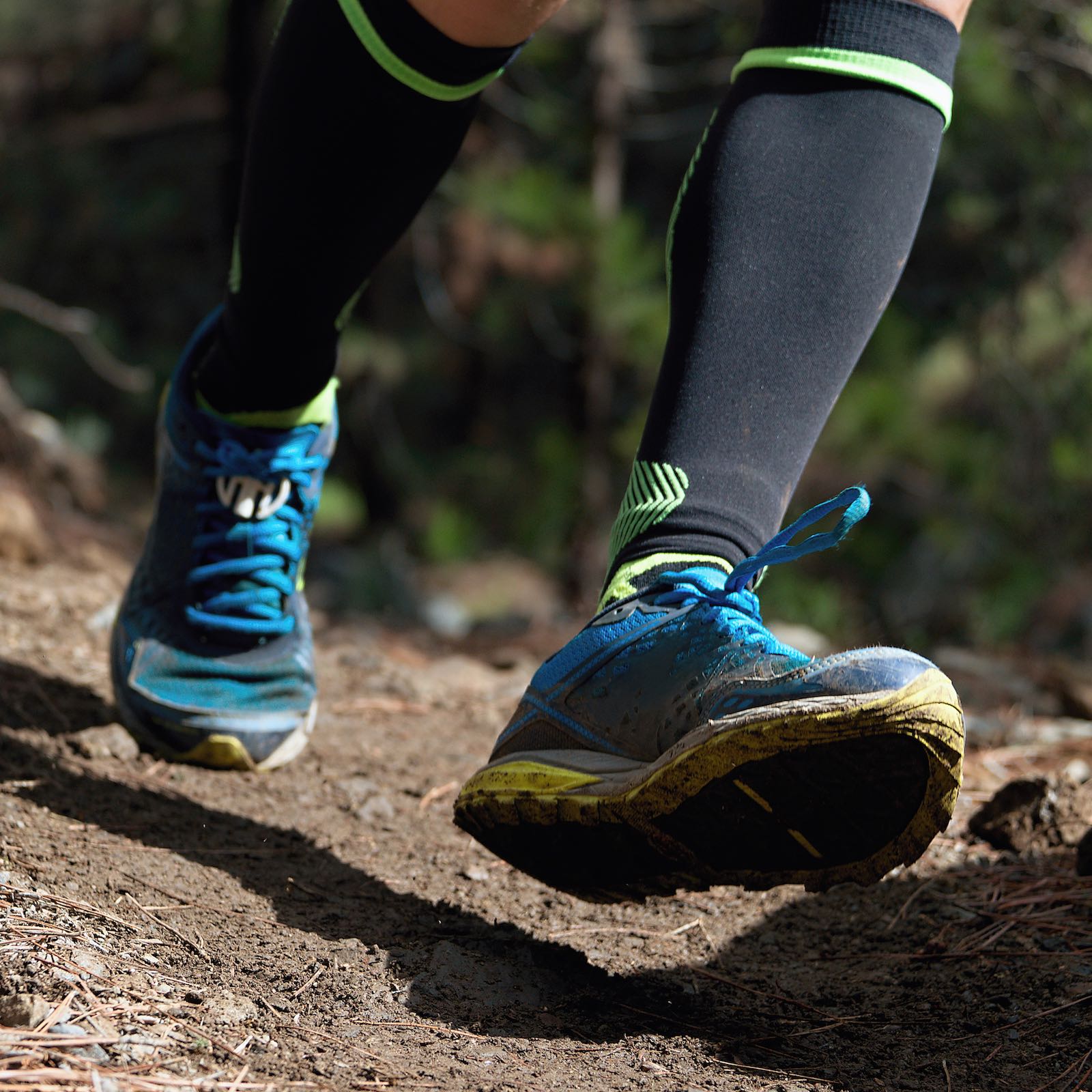Running and hiking shoes: seemingly similar, yet vastly different. Both support your feet, but their designs cater to distinct needs and activities. This guide delves into the key differences between running and hiking shoes, exploring their construction, features, fit, performance, and maintenance. We’ll examine the technologies that make modern footwear so effective and help you choose the perfect pair for your adventures, whether pounding pavements or conquering mountains.
From the cushioning systems that absorb impact to the outsole designs that grip various terrains, we’ll cover everything you need to know to make an informed decision. Understanding the nuances of fit, breathability, and durability will empower you to select footwear that enhances performance and comfort, ultimately protecting your feet and maximizing your enjoyment of running and hiking.
Shoe Types
Choosing between running shoes and hiking shoes depends heavily on your intended activity. While there’s some overlap, their designs prioritize different needs, resulting in distinct features and construction. Understanding these differences is crucial for comfort, performance, and injury prevention.
Running shoes are designed for forward momentum on paved or relatively smooth surfaces, emphasizing cushioning and responsiveness. Hiking shoes, on the other hand, prioritize stability, protection, and traction on uneven and potentially rough terrain. They often incorporate features to support the ankle and protect the foot from impacts with rocks and debris.
Running Shoe and Hiking Shoe Design Features
The table below highlights key design differences between typical running and hiking shoes.
| Feature | Running Shoe | Hiking Shoe | Key Differences |
|---|---|---|---|
| Cushioning | High level of cushioning in the midsole, often using EVA foam or similar materials. | Moderate cushioning; priority given to stability and support. May incorporate firmer midsole materials. | Running shoes prioritize shock absorption; hiking shoes prioritize stability and protection from impacts. |
| Support | Moderate to high arch support, depending on the model and runner’s needs. | High level of ankle and midfoot support, often with stiffer construction. | Running shoes focus on support during forward motion; hiking shoes provide enhanced stability on uneven terrain. |
| Weight | Generally lighter weight for improved speed and efficiency. | Generally heavier due to durable materials and protective features. | Weight is a trade-off between performance and protection. |
| Flexibility | More flexible sole for a natural stride. | Less flexible sole for stability and protection from sharp objects. | Flexibility is prioritized in running shoes for efficiency; stiffness is prioritized in hiking shoes for protection and stability. |
| Water Resistance | Generally not waterproof, though some models offer water-resistant treatments. | Often incorporates waterproof or water-resistant membranes (e.g., Gore-Tex). | Water resistance is a key feature for hiking shoes, especially in wet conditions. |
Materials Used in Shoe Construction
The materials used significantly impact a shoe’s weight, durability, and breathability. Running shoes often prioritize lightweight materials for speed, while hiking shoes emphasize durability and protection.
Running shoes frequently utilize lightweight mesh uppers for breathability, combined with EVA (ethylene-vinyl acetate) foam midsoles for cushioning. Outersoles are typically made of rubber compounds designed for grip on paved surfaces. Hiking shoes often incorporate more durable materials like leather or synthetic leathers in the upper for abrasion resistance. Midsoles might use firmer foams or even plastic plates for support and protection.
Find out about how pinnacles national park hiking can deliver the best answers for your issues.
Outersoles are usually made from tougher rubber compounds with deeper treads for improved traction on varied terrain.
Outsole Designs, Running and hiking shoes
Outsole design is critical for both running and hiking shoes, determining grip and traction. The differences reflect the distinct demands of each activity.
Running shoe outsoles typically feature a relatively flat profile with strategically placed rubber lugs (projections) for grip on paved surfaces. The pattern and spacing of these lugs are designed to optimize traction during different phases of the running gait. Hiking shoe outsoles, in contrast, often feature deeper and more aggressive lug patterns for improved traction on uneven, rocky, or muddy surfaces.
These lugs provide better grip on inclines, declines, and unpredictable terrain. The rubber compound used in hiking shoe outsoles is generally tougher and more durable to withstand abrasion and wear.
Performance and Use Cases
.jpg)
Running shoes and hiking shoes, while both footwear designed for movement, excel in vastly different environments and activities. Their performance characteristics are tailored to specific needs, making the choice between them crucial for comfort, safety, and overall performance. Understanding these differences is key to selecting the right footwear for your intended use.
The following table compares the performance of running and hiking shoes across various terrains, highlighting their strengths and weaknesses.
Performance Comparison Across Terrains
| Shoe Type | Paved Roads | Trails (Smooth) | Trails (Rocky/Uneven) | Mountains (Steep/Technical) |
|---|---|---|---|---|
| Running Shoes (Road) | Excellent cushioning, responsiveness, lightweight | Good, but may lack traction and protection on uneven surfaces | Poor, lack of ankle support and protection can lead to injury | Unacceptable, insufficient protection and support for steep inclines and unstable terrain |
| Running Shoes (Trail) | Acceptable, but may feel stiff and less responsive | Good traction, moderate cushioning and protection | Good, improved protection and grip compared to road running shoes | Fair, suitable for some less technical mountain trails, but may lack sufficient ankle support for challenging climbs |
| Hiking Shoes (Lightweight) | Fair, acceptable for short distances but may lack cushioning | Good, balance of comfort and protection | Good, durable outsoles provide good traction | Acceptable for moderate mountain hikes, but may lack support for very steep or technical terrain |
| Hiking Boots (Heavy-duty) | Poor, heavy and inflexible | Fair, good protection but can feel cumbersome | Good, excellent ankle support and protection | Excellent, provide superior ankle support, protection, and traction on challenging terrain |
Running Shoe Selection for Different Running Styles
The ideal running shoe depends heavily on the runner’s style and the type of running they do. Choosing the wrong shoe can lead to discomfort and injury.
Road runners typically prioritize lightweight, responsive shoes with good cushioning for long distances on paved surfaces. Trail runners, on the other hand, need shoes with aggressive treads for grip, protective features to shield their feet from rocks and roots, and often more robust construction for stability on uneven terrain. Ultra-marathon runners require shoes that combine cushioning, durability, and protection to withstand the extreme distances and challenging conditions.
Footwear Selection for Hiking Activities
Choosing the right footwear for hiking depends on the type of hike and the terrain. Different activities demand different levels of support, protection, and comfort.
Day hikes on relatively smooth trails might only require lightweight hiking shoes. Backpacking trips, involving heavier loads and longer distances, often benefit from more supportive hiking boots. Technical climbs and mountaineering require sturdy, high-cut boots that provide excellent ankle support and protection against harsh conditions. Consider factors like waterproofing, breathability, and the weight of your pack when making your selection.
Price and Value: Running And Hiking Shoes

Choosing between running and hiking shoes often involves considering the price tag alongside the features. Prices vary significantly depending on the brand, technology used, and intended performance level. Understanding this relationship is key to making an informed purchase.Price ranges for both running and hiking shoes are broad, spanning from budget-friendly options to high-end, performance-focused models. The price reflects not only the materials used but also the research and development invested in the shoe’s design and technology.
Price Distribution Across Brands and Performance Levels
A hypothetical bar chart illustrating price distribution would show a wide range. Budget running shoes might cluster between $50 and $100, while high-performance models could extend beyond $200. Similarly, hiking shoes would display a similar spread, with basic hiking boots falling within the $80-$150 range and advanced, technical boots reaching prices upwards of $250. Established brands like Salomon, Hoka One One, and Brooks tend to sit at the higher end of the spectrum, reflecting their investment in innovative technologies and materials.
More affordable brands offer comparable performance at lower price points, often by utilizing less expensive materials or simplifying designs.
Price and Shoe Features, Materials, and Intended Use
The price of a shoe is directly correlated to its features, materials, and intended use. Higher-priced shoes generally incorporate more advanced technologies. For instance, a high-end running shoe might feature carbon fiber plates for enhanced propulsion, responsive cushioning materials like Pebax, and specialized outsoles designed for specific terrains. In hiking shoes, a higher price tag often translates to more durable, waterproof materials like Gore-Tex, advanced ankle support systems, and stiffer midsoles for stability on uneven terrain.
Budget-friendly options often compromise on these features, using simpler materials and construction methods. A trail running shoe designed for technical terrain will typically cost more than a basic road running shoe, reflecting the need for enhanced grip, protection, and durability.
Value for Money in Running and Hiking Shoes
Determining value for money depends on individual needs and priorities. A highly technical running shoe might be worth the investment for a serious marathon runner, while a less expensive option might suffice for a casual jogger. Similarly, a lightweight hiking shoe might be ideal for day hikes on well-maintained trails, while a heavier, more durable boot is necessary for backpacking trips with heavy loads.
Considering the intended use, frequency of use, and personal preferences is crucial in evaluating whether a shoe’s price aligns with its value. A more expensive shoe might offer superior comfort, performance, and durability, leading to a longer lifespan and ultimately better value over time, while a cheaper shoe might be sufficient for occasional use.
Choosing the right footwear is crucial for both running and hiking, directly impacting performance, comfort, and injury prevention. By understanding the unique features and considerations for each type of shoe, you can confidently select a pair that meets your specific needs and activity level. Whether you’re a seasoned athlete or a weekend warrior, this guide has equipped you with the knowledge to make an informed purchase and enjoy your chosen activity to the fullest.
Remember to prioritize proper fit, regular maintenance, and timely replacement for optimal performance and longevity of your shoes.
General Inquiries
How often should I replace my running shoes?
Generally, running shoes should be replaced every 300-500 miles, or sooner if you notice significant wear and tear.
Can I use hiking boots for running?
No, hiking boots are too stiff and heavy for running, increasing your risk of injury.
What’s the difference between trail running shoes and road running shoes?
Trail running shoes have more aggressive tread for grip on uneven surfaces, while road running shoes prioritize cushioning and responsiveness on paved roads.
How do I clean my hiking boots?
Use a brush and mild soap and water to clean your boots. Allow them to air dry completely.



